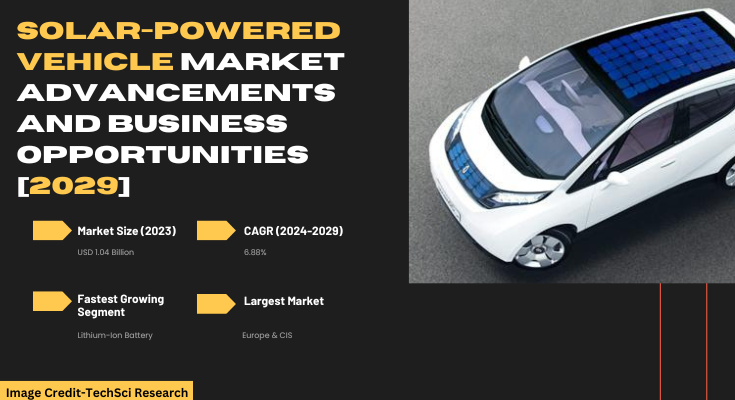According to TechSci Research report, “Solar-Powered Vehicle Market – Global Industry Size, Share, Trends, Competition Forecast & Opportunities, 2029”, the Global Solar-Powered Vehicle Market stood at USD 1.04 Billion in 2023 and is anticipated to grow with a CAGR of 6.88% in the forecast period, 2025-2029. The solar-powered vehicle market has emerged as a promising segment within the automotive industry, driven by the increasing emphasis on sustainable transportation solutions and the growing adoption of renewable energy technologies. Solar-powered vehicles utilize photovoltaic cells to convert sunlight into electricity, which is then used to power the vehicle’s electric motor or recharge its onboard battery pack. These vehicles represent a clean and environmentally friendly alternative to traditional gasoline-powered vehicles, offering reduced greenhouse gas emissions and decreased dependence on fossil fuels.
One of the primary drivers of the solar-powered vehicle market is the growing awareness of environmental issues and the need to reduce carbon emissions from transportation. Solar-powered vehicles offer an eco-friendly mode of transportation that can help mitigate the environmental impact of traditional vehicles powered by internal combustion engines. By harnessing solar energy to generate electricity, these vehicles produce zero tailpipe emissions, contributing to cleaner air and a healthier environment.
Moreover, advancements in solar technology and improvements in photovoltaic cell efficiency have enhanced the feasibility and practicality of solar-powered vehicles. Manufacturers are incorporating lightweight and flexible solar panels into vehicle designs, allowing for seamless integration onto vehicle surfaces such as roofs, hoods, and windows. These advancements enable solar-powered vehicles to capture and utilize solar energy more effectively, extending their range and reducing reliance on grid electricity for charging.
Furthermore, the increasing focus on energy independence and resilience has spurred interest in solar-powered vehicles as a sustainable transportation solution. Solar-powered vehicles can harness energy from the sun to charge their batteries, reducing the need for external charging infrastructure and providing greater autonomy for drivers, especially in remote or off-grid locations. This autonomy makes solar-powered vehicles particularly attractive for applications such as off-road exploration, camping, and emergency response, where access to traditional charging infrastructure may be limited.
Additionally, government incentives and policies aimed at promoting renewable energy adoption and reducing carbon emissions are driving market growth for solar-powered vehicles. Incentives such as tax credits, rebates, and grants encourage consumers to invest in solar-powered vehicles, making them more financially accessible and incentivizing adoption. Furthermore, regulatory mandates and emissions standards are prompting automakers to develop and introduce solar-powered vehicles as part of their broader efforts to meet sustainability targets and comply with environmental regulations.
In conclusion, the solar-powered vehicle market is witnessing steady growth driven by increasing environmental consciousness, advancements in solar technology, energy independence goals, and supportive government policies. As the automotive industry continues to embrace sustainability and renewable energy solutions, solar-powered vehicles are poised to play a significant role in shaping the future of transportation, offering a clean, efficient, and environmentally friendly mode of mobility for consumers worldwide.
Browse over market data Figures spread through 180 Pages and an in-depth TOC on “ Global Solar-Powered Vehicle Market.” @ https://www.techsciresearch.com/report/solar-powered-vehicle-market/21164.html
The solar-powered vehicle market is experiencing steady growth across multiple regions, including Asia Pacific, North America, Europe & CIS, South America, and the Middle East & Africa. Solar-powered vehicles utilize photovoltaic cells to convert sunlight into electricity, offering a sustainable and eco-friendly alternative to conventional gasoline-powered vehicles. The market for solar-powered vehicles is driven by factors such as increasing environmental awareness, government initiatives to promote clean energy, and technological advancements in solar technology.
In the Asia Pacific region, which encompasses countries like China, India, Japan, and South Korea, the solar-powered vehicle market is witnessing significant growth. The region’s dense population, coupled with concerns about air pollution and climate change, has led to a growing demand for environmentally friendly transportation solutions. Moreover, government incentives and subsidies for electric and solar-powered vehicles further propel market growth in the region.
North America stands as another prominent market for solar-powered vehicles, with the United States and Canada leading the way. The region’s strong emphasis on sustainability and clean energy initiatives drives the adoption of solar-powered vehicles. Additionally, technological advancements in solar technology and battery storage solutions contribute to the increasing feasibility and popularity of solar-powered vehicles among consumers in North America.
Europe & CIS also play a significant role in the global solar-powered vehicle market, with countries like Germany, France, and the United Kingdom leading the adoption of renewable energy solutions. The region’s stringent emissions regulations and targets for reducing greenhouse gas emissions drive the demand for eco-friendly transportation options like solar-powered vehicles. Furthermore, the European Union’s ambitious clean energy goals and investments in renewable energy infrastructure support market growth in Europe & CIS.
South America presents a growing market for solar-powered vehicles, albeit at a slower pace compared to other regions. Countries like Brazil, Argentina, and Chile are witnessing increasing interest in sustainable transportation solutions, driven by environmental concerns and government incentives for electric and solar-powered vehicles. Additionally, the region’s abundant sunlight and favorable climate conditions make it conducive to the adoption of solar-powered vehicles.
The Middle East & Africa region also contributes to the solar-powered vehicle market, with countries like the United Arab Emirates, Saudi Arabia, and South Africa exploring renewable energy solutions for transportation. The region’s focus on diversifying its energy mix and reducing dependence on fossil fuels drives investments in solar-powered vehicles and infrastructure. Moreover, initiatives aimed at promoting clean energy and reducing carbon emissions further support market growth in the Middle East & Africa.
Overall, the global solar-powered vehicle market is characterized by steady growth across multiple regions, driven by increasing environmental awareness, government support for clean energy, and technological advancements in solar technology. While each region presents unique opportunities and challenges, the adoption of solar-powered vehicles is expected to continue growing as the world transitions towards a more sustainable and eco-friendly transportation ecosystem.
Major companies operating in the Global Solar-Powered Vehicle Market are:
- Guangzhou Jcar Industrial Company Ltd
- Hanergy Holding Group
- Venturi Eclectic
- Sono Motors GmbH
- Ford Motor Company
- Mahindra & Mahindra
- Cruise Car
- The Solar Electric Vehicle Company
- Kiira Motors Corporation (KMC)
- Immortus
Download Free Sample Report @ https://www.techsciresearch.com/sample-report.aspx?cid=21164
Customers can also request 10% free customization in this report.
“The global adoption of solar-powered vehicles marks a pivotal shift towards a greener future. The convergence of advancements in solar technology, government incentives, and a heightened environmental consciousness positions solar-powered mobility as a transformative force in the automotive industry, offering a compelling solution to reduce carbon emissions and promote sustainable living. As the world accelerates towards renewable energy, solar-powered vehicles stand as a tangible embodiment of innovation, pushing the boundaries of what’s possible in creating a more eco-friendly and efficient transportation ecosystem,” said Mr. Karan Chechi, Research Director with TechSci Research, a research-based management consulting firm.
“Solar-Powered Vehicle Market – Global Industry Size, Share, Trends Opportunity, and Forecast, Segmented By Solar Panel (Monocrystalline Solar Panel and Polycrystalline Solar Panel), By Battery Type (Lithium-Ion Battery, Lead-Acid Battery, Lead-Carbon Battery and Others), By Propulsion (Battery Vehicles and Hybrid Electric Vehicles), By Region, Competition, 2019-2029”, has evaluated the future growth potential of Global Solar-Powered Vehicle Market and provides statistics & information on market size, structure, and future market growth. The report intends to provide cutting-edge market intelligence and help decision makers take sound investment decisions. Besides, the report also identifies and analyzes the emerging trends along with essential drivers, challenges, and opportunities in the Global Solar-Powered Vehicle Market.
You may also read:
Luxury Yacht Market [2029] Exploring Potential, Growth, Future & Trends
All Weather Tire Market [2029] – Analysis, Trends, & Insights
Electric Bus Charging Infrastructure Market Advancements and Business Opportunities [2029]
Automotive Steering Knuckle Market – A Comprehensive Report [2029]
Electric Cargo Bikes Market [2029] Exploring Potential, Growth, Future & Trends
Electric Truck Market [2029]- A Deep Dive into the Latest Market Trends, Market Segmentation
Table of Content-Solar-Powered Vehicle Market
- Introduction
1.1. Product Overview
1.2. Key Highlights of the Report
1.3. Market Coverage
1.4. Market Segments Covered
1.5. Research Tenure Considered
- Research Methodology
2.1. Objective of the Study
2.2. Baseline Methodology
2.3. Key Industry Partners
2.4. Major Association and Secondary Sources
2.5. Forecasting Methodology
2.6. Data Triangulation & Validation
2.7. Assumptions and Limitations
- Executive Summary
3.1. Market Overview
3.2. Market Forecast
3.3. Key Regions
3.4. Key Segments
- Impact of COVID-19 on Global Solar-Powered Vehicle Market
- Global Solar-Powered Vehicle Market Outlook
5.1. Market Size & Forecast
5.1.1. By Value
5.2. Market Share & Forecast
5.2.1. By Solar Panel Market Share Analysis (Monocrystalline Solar Panel and Polycrystalline Solar Panel))
5.2.2. By Battery Type Market Share Analysis (Lithium-Ion Battery, Lead-Acid Battery, Lead-Carbon Battery and Others)
5.2.3. By Propulsion Market Share Analysis (Battery Vehicles and Hybrid Electric Vehicles)
5.2.4. By Region Market Share Analysis
5.2.4.1. Asia-Pacific Market Share Analysis
5.2.4.2. Europe & CIS Market Share Analysis
5.2.4.3. North America Market Share Analysis
5.2.4.4. South America Market Share Analysis
5.2.4.5. Middle East & Africa Market Share Analysis
5.2.5. By Company Market Share Analysis (Top 5 Companies, Others – By Value, 2023)
5.3. Global Solar-Powered Vehicle Market Mapping & Opportunity Assessment
5.3.1. By Solar Panel Market Mapping & Opportunity Assessment
5.3.2. By Battery Type Market Mapping & Opportunity Assessment
5.3.3. By Propulsion Market Mapping & Opportunity Assessment
5.3.4. By Regional Market Mapping & Opportunity Assessment
- Asia-Pacific Solar-Powered Vehicle Market Outlook
6.1. Market Size & Forecast
6.1.1. By Value
6.2. Market Share & Forecast
6.2.1. By Solar Panel Market Share Analysis
6.2.2. By Battery Type Market Share Analysis
6.2.3. By Propulsion Market Share Analysis
6.2.4. By Country Market Share Analysis
6.2.4.1. China Market Share Analysis
6.2.4.2. India Market Share Analysis
6.2.4.3. Japan Market Share Analysis
6.2.4.4. Indonesia Market Share Analysis
6.2.4.5. Thailand Market Share Analysis
6.2.4.6. South Korea Market Share Analysis
6.2.4.7. Australia Market Share Analysis
6.2.4.8. Rest of Asia-Pacific Market Share Analysis
6.3. Asia-Pacific: Country Analysis
6.3.1. China Solar-Powered Vehicle Market Outlook
6.3.1.1. Market Size & Forecast
6.3.1.1.1. By Value
6.3.1.2. Market Share & Forecast
6.3.1.2.1. By Solar Panel Market Share Analysis
6.3.1.2.2. By Battery Type Market Share Analysis
6.3.1.2.3. By Propulsion Market Share Analysis
6.3.2. India Solar-Powered Vehicle Market Outlook
6.3.2.1. Market Size & Forecast
6.3.2.1.1. By Value
6.3.2.2. Market Share & Forecast
6.3.2.2.1. By Solar Panel Market Share Analysis
6.3.2.2.2. By Battery Type Market Share Analysis
6.3.2.2.3. By Propulsion Market Share Analysis



